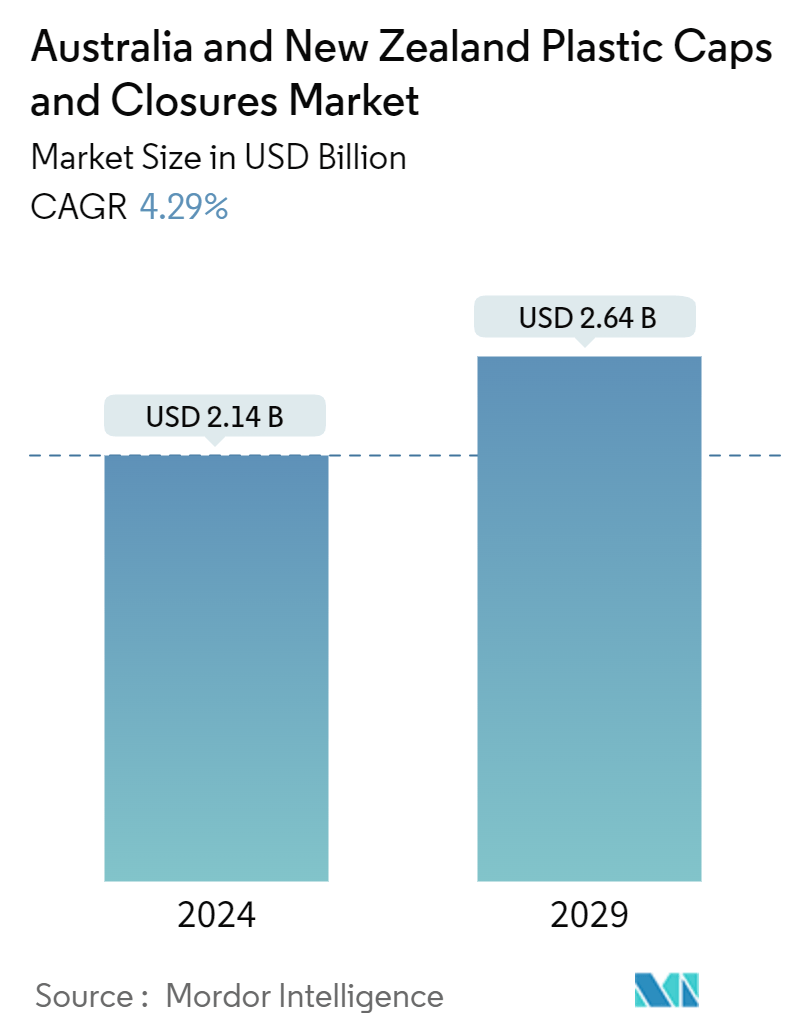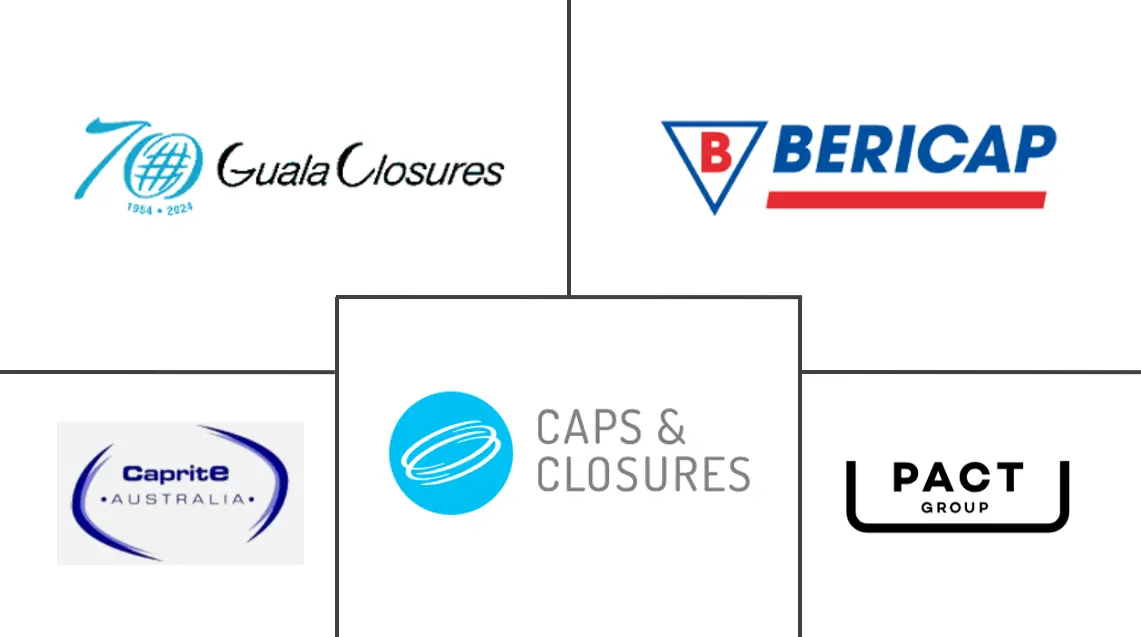Market Size of Australia And New Zealand Plastic Caps And Closures Industry

| Study Period | 2024 - 2029 |
| Base Year For Estimation | 2023 |
| Market Size (2024) | USD 2.14 Billion |
| Market Size (2029) | USD 2.64 Billion |
| CAGR (2024 - 2029) | 4.29 % |
| Market Concentration | Medium |
Major Players
*Disclaimer: Major Players sorted in no particular order |
Australia and New Zealand Plastic Caps and Closures Market Analysis
The Australia And New Zealand Plastic Caps And Closures Market size is estimated at USD 2.14 billion in 2024, and is expected to reach USD 2.64 billion by 2029, growing at a CAGR of 4.29% during the forecast period (2024-2029). In terms of shipment volume, the market is expected to grow from 12.78 billion units in 2024 to 15.21 billion units by 2029, at a CAGR of 3.54% during the forecast period (2024-2029).
- Australia and New Zealand are witnessing a surge in demand for plastic caps and closures, driven by sectors like food, beverage, personal care, cosmetics, pharmaceuticals, and industry. In Australia, the food and beverage (F&B) manufacturing sector bolsters scalability and competitiveness and underpins the nation's supply chain resilience. Notably, Australia's food processing industry, the largest in the country, accounts for a significant one-third of all manufacturing activities, further fueling the need for diverse plastic closures.
- Concurrently, New Zealand's beverage sector is propelling the demand for plastic caps, reflecting the nation's evolving consumer preferences and heightened consumption. Data from the New Zealand Beverage Council (NZBC) reveals that Kiwi households collectively spend nearly USD 700 million annually on soft drinks and juices, with a breakdown of around USD 284 million on soft drinks, USD 143 million on fruit and vegetable juices, and USD 20 million on energy drinks.
- Key players like Bericap Holding GmbH, Guala Closures SPA, and Pact Group Holdings Ltd are at the forefront, focusing on crafting lightweight closures tailored for various applications, be it in food, beverages, cosmetics, or personal care. Their product offerings span from dispensing flip-tops, pumps, and fine mist sprays to tamper-evident caps catering to a spectrum of industries. Moreover, these manufacturers are increasingly diversifying their portfolio, introducing specialty and bespoke caps, further propelling the market in both Australia and New Zealand.
- Despite the market's growth trajectory, there's a looming concern over the environmental impact of plastic caps and closures in Australia and New Zealand. The prevalent practice of sending plastic waste, including bottles and caps, to landfills often leads to incineration, a process that not only occupies valuable space but also releases harmful pollutants, significantly compromising air quality, a pressing challenge for the market's continued expansion.
Australia and New Zealand Plastic Caps and Closures Industry Segmentation
The scope of the study characterizes the plastic caps and closures market based on the raw material of the product, including PP, PE, PET, and other raw materials used across various end-user industries such as food, pharmaceuticals, beverages, cosmetics, toiletries, and more across the country. The research also examines underlying growth influencers and significant industry vendors, all of which help to support market estimates and growth rates throughout the anticipated period. The market estimates and projections are based on the base year factors and arrived at top-down and bottom-up approaches.
Australian and New Zealand plastic caps and closures market is segmented by resin (polyethylene (pe), polyethylene terephthalate (pet), polypropylene (pp) and other plastic materials), by product type (threaded, dispensing, unthreaded, and child-resistant), by end-use industries (food, beverage (bottled water, carbonated soft drinks, alcoholic beverages, juices and energy drinks, and others), personal care and cosmetics, household chemicals, and other end-user industries) and by country (Australia and New Zealand). The market sizing and forecasts are provided in terms of volume (units) and revenue (USD) for all the above segments.
| By Resin | |
| Polyethylene (PE) | |
| Polyethylene Terephthalate (PET) | |
| Polypropylene (PP) | |
| Other Plastic Materials (Polystyrene, PVC, Polycarbonate, etc.) |
| By Product Type | |
| Threaded | |
| Dispensing | |
| Unthreaded | |
| Child-resistant |
| By End-user Industries | |||||||
| Food | |||||||
| |||||||
| Personal Care and Cosmetics | |||||||
| Household Chemicals | |||||||
| Other End-user Industries |
| By Country | |
| Australia | |
| New Zealand |
Australia And New Zealand Plastic Caps And Closures Market Size Summary
The plastic caps and closures market in Australia and New Zealand is experiencing significant growth, driven by increasing demand across various sectors such as food, beverages, personal care, cosmetics, and pharmaceuticals. In Australia, the robust food and beverage manufacturing sector plays a crucial role in this expansion, with the country's food processing industry being a major contributor to manufacturing activities. Meanwhile, New Zealand's evolving consumer preferences and heightened beverage consumption are propelling the demand for plastic caps. Key industry players like Bericap Holding GmbH, Guala Closures SPA, and Pact Group Holdings Ltd are leading the market by developing lightweight and innovative closure solutions tailored for diverse applications. These manufacturers are also diversifying their product offerings to include specialty and bespoke caps, further stimulating market growth.
Despite the positive growth trajectory, environmental concerns regarding plastic waste management pose challenges to the market's expansion. The reliance on cost-effective materials such as polypropylene (PP) and polyethylene (PE) for manufacturing caps and closures is prevalent, with these materials offering benefits like leak prevention and tamper resistance. The market is also witnessing a shift towards lightweight and user-friendly designs, catering to the fast-paced lifestyles of consumers in both countries. The increasing popularity of packaged beverages, particularly health-conscious options, is further driving demand for plastic caps and closures. The market landscape is moderately consolidated, with both domestic and international players actively engaging in product development, partnerships, and strategic acquisitions to strengthen their market presence.
Australia And New Zealand Plastic Caps And Closures Market Size - Table of Contents
-
1. MARKET INSIGHTS
-
1.1 Market Overview
-
1.2 Industry Value Chain Analysis
-
1.3 Industry Attractiveness - Porter's Five Forces Analysis
-
1.3.1 Bargaining Power of Suppliers
-
1.3.2 Bargaining Power of Buyers
-
1.3.3 Threat of New Entrants
-
1.3.4 Threat of Substitutes Products
-
1.3.5 Intensity of Competitive Rivalry
-
-
-
2. MARKET SEGMENTATION
-
2.1 By Resin
-
2.1.1 Polyethylene (PE)
-
2.1.2 Polyethylene Terephthalate (PET)
-
2.1.3 Polypropylene (PP)
-
2.1.4 Other Plastic Materials (Polystyrene, PVC, Polycarbonate, etc.)
-
-
2.2 By Product Type
-
2.2.1 Threaded
-
2.2.2 Dispensing
-
2.2.3 Unthreaded
-
2.2.4 Child-resistant
-
-
2.3 By End-user Industries
-
2.3.1 Food
-
2.3.2 Beverage
-
2.3.2.1 Bottled Water
-
2.3.2.2 Carbonated Soft Drinks
-
2.3.2.3 Alcoholic Beverages
-
2.3.2.4 Juices and Energy Drinks
-
2.3.2.5 Other Beverages
-
-
2.3.3 Personal Care and Cosmetics
-
2.3.4 Household Chemicals
-
2.3.5 Other End-user Industries
-
-
2.4 By Country
-
2.4.1 Australia
-
2.4.2 New Zealand
-
-
Australia And New Zealand Plastic Caps And Closures Market Size FAQs
How big is the Australia And New Zealand Plastic Caps And Closures Market?
The Australia And New Zealand Plastic Caps And Closures Market size is expected to reach USD 2.14 billion in 2024 and grow at a CAGR of 4.29% to reach USD 2.64 billion by 2029.
What is the current Australia And New Zealand Plastic Caps And Closures Market size?
In 2024, the Australia And New Zealand Plastic Caps And Closures Market size is expected to reach USD 2.14 billion.

